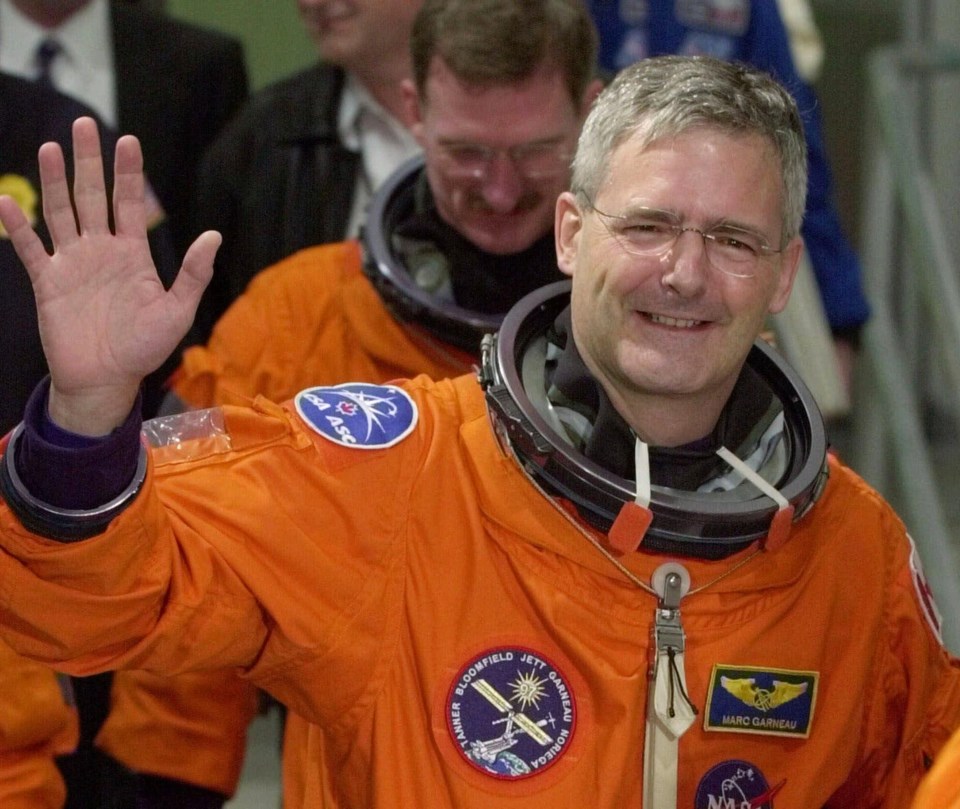MONTREAL — Canadian scientists working on asteroid missions, exploring the universe through the James Webb Space Telescope or helping to put rovers on Mars say they can in some way thank Marc Garneau, who left an enduring legacy both as an astronaut and head of the country's space agency.
While best-known in later years as a federal cabinet minister, Garneau, who died this week at 76, was also a Navy officer, a systems engineer, and an astronaut with a lifelong passion for science, according to his friends and colleagues.
In 1984, he made history as the first Canadian in space when he served as a payload specialist aboard the Space Shuttle Challenger. He returned to space twice more, in 1996 and 2000, before serving as the president of the Canadian Space Agency from 2001 to 2005.
"All his life was devoted to public service," said Gilles Leclerc, an ex-CSA official who worked with him. "And he was really a role model to all the Canadian astronauts who came after him."
As CSA president, Garneau laid the building blocks for the space exploration program that would bring together other initiatives previously developed separately, Leclerc said.
He was also "ahead of his time" when it came to being conscious of the environment and understanding the importance of applying space technology for practical uses such as satellite communications.
"During his tenure, he really wanted us to focus more on science: astronomy, planetary science, lunar exploration," Leclerc said in a phone interview.
"So all these things that now we see, all these missions that Canada participated in, like a mission to the asteroids, two missions to Mars, the James Webb Space Telescope...Marc had a real strong influence in shaping the future of the space program for a long time."
On Friday, CSA President Lisa Campbell paid tribute to Garneau, who she called a "cherished member of the space agency family."
"We remain deeply grateful for his extraordinary public service and enduring contributions to Canada and the world, from making history as the first Canadian in space to guiding the Canadian Space Agency as its president," she said at an event at the agency's Montreal-area headquarters.
"his integrity, his generosity of spirit touches everyone who had the privilege of working with him."
Flags at government buildings in Montreal have been lowered to half-mast in tribute.
Garneau would carry his love of science — as well as his significant technical knowledge — into his next role as a politician, according to his former chief of staff and close personal friend.
Marc Roy said Garneau decided to run for office out of a desire to give back after his successful space career. Garneau often spoke about how seeing the Earth from above "changed his perspective on many things," including conflicts and environmental protections, Roy said.
"So many things that unfortunately divide us as humans that become so irrelevant when you look at our world from abroad," Roy said in a phone interview. "And that desire to want to contribute at an even higher level, at a different, at a policy level, at a governance level is what inspired him to run for federal politics."
Garneau was elected as MP in Notre-Dame-de-Grâce–Westmount in 2008 after failing to win another Montreal-area seat in 2006.
Roy said Garneau's scientific background shone through most clearly as Transport minister, when he was able to instantly grasp technical briefings on ships, planes and trains. Above all, his history as a naval officer and astronaut gave him a laser focus on safety, Roy said, in a role that would see Garneau introduce measures including the safer skies initiative, and the oceans protection plan to monitor ship traffic, oil spills and wildlife.
Roy said Garneau often spoke about the weight of the portfolio, "wanting to ensure that he did it to the best of his ability, that he truly understood every decision that he was taking and every decision that was possible for him to make in order to ensure the safety of the traveling public and the safety overall of our trade and transportation corridors."
Roy said Garneau brought a scientist's analytic, "Spock-like" demeanor to his roles. But he said some of the issues Garneau championed most passionately were social causes, including serving as a joint chair of the special joint committee on medical assistance in dying.
And, despite his considerable intelligence, Roy said Garneau remained humble.
"He had a very rare quality in a politician, from his very debut until the very last day before he retired as member of Parliament, which was: he listened more than he talked," Roy said.
He said his friend was diagnosed only months ago with two cancers: leukemia and lymphoma, and died after a battle that was "brave but short."
Roy said his friend's time since retirement was spent enjoying time with his wife, Pam, and his children, and completing work on his autobiography, "A Most Extraordinary Ride: Space, Politics and the Pursuit of a Canadian Dream." Roy said the book gave Garneau closure.
"He wanted to tell the story that, 'I'm just like everybody else and I failed and I've screwed up and I pulled up my socks and I learned from my mistakes and I moved on,'" Roy said. "And that was very important for him to tell that story, and I'm just so fortunate that he had the time to do that."
This report by The Canadian Press was first published June 7, 2025.
Morgan Lowrie and Sidhartha Banerjee, The Canadian Press



